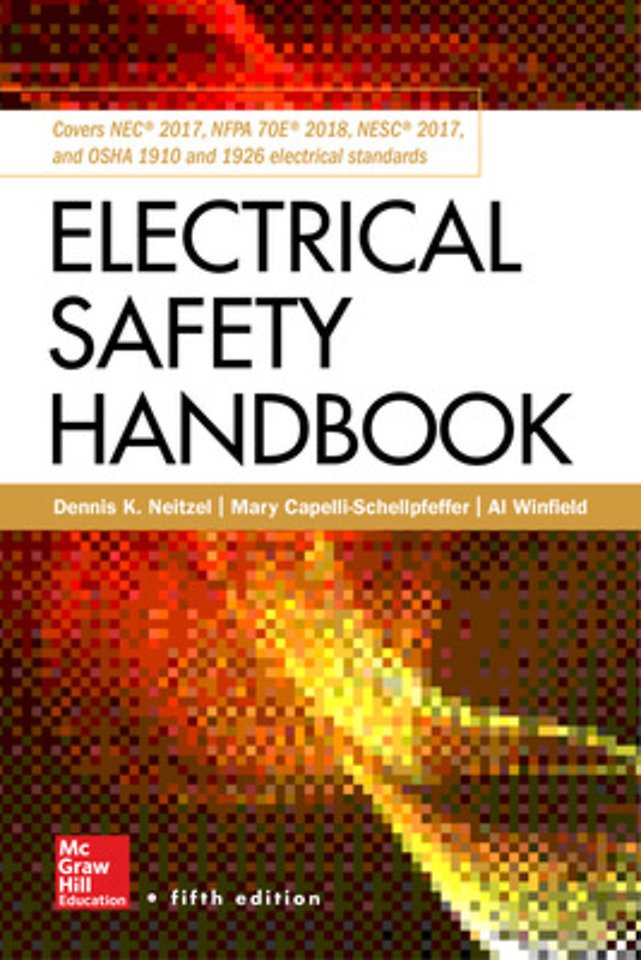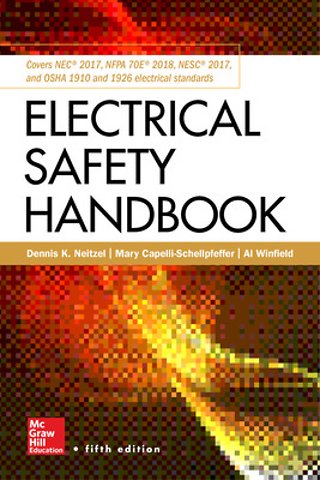Electrical Safety Handbook
Samenvatting
Publisher's Note: Products purchased from Third Party sellers are not guaranteed by the publisher for quality, authenticity, or access to any online entitlements included with the product.
On-the-job electrical safety essentials—thoroughly revised for the latest procedures and standards
This fully updated electrical safety guide is a practical, illustrated source of life-saving information designed for specific work environments. The book has been fully revised and expanded to conform to every current major electrical standard, including NEC, NESC, NFPA70E, IEEE 1584, and OSHA.
Written by experts in electrical operations, maintenance, engineering, construction, and safety, Electrical Safety Handbook, Fifth Edition provides the most up-to-date safety strategies in an easy-to-use format. The book delivers complete details on electrical hazards, safety equipment, management, training, regulatory and legal requirements, accident prevention, and much more. You will find new sections on electrical grounding, heat transfer theory as it relates to the human body, and the medical aspects of electrical trauma.
•Contains comprehensive coverage of every subject on the exam•Includes updated electrical grounding concepts and applications•Written by a team of electrical safety experts
Specificaties
Inhoudsopgave
ered <br/> The National Electrical Code (NEC)—NFPA 70 <br/> General Description <br/> Industries and Facilities Covered <br/> Technical and Safety Items Covered <br/> Electrical Equipment Maintenance—NFPA 70B <br/> General Description <br/> Industries and Facilities Covered <br/> Technical and Safety Items Covered <br/> Standard for Electrical Safety in the Workplace—NFPA 70E <br/> General Description <br/> Industries and Facilities Covered <br/> Technical and Safety Items Covered <br/> American Society for Testing and Materials (ASTM) Standards <br/> Occupational Safety and Health Administration (OSHA) Standards <br/> Overview <br/> General Industry <br/> Construction Industry <br/> Chapter 8. Accident Prevention, Accident Investigation, Rescue, and First Aid <br/> Introduction <br/> Accident Prevention <br/> Individual Responsibility <br/> Installation Safety <br/> Power System Studies <br/> First Aid <br/> General First Aid <br/> Resuscitation (Artificial Respiration) <br/> Heart-Lung Resuscitation <br/> Automated External Defibrillator (AED) <br/> How an AED Works <br/> When Should an AED Be Used? <br/> How to Use an Automated External Defibrillator <br/> What Risks Are Associated with Using an Automated External Defibrillator? <br/> Key Points about Automated External Defibrillators <br/> Rescue Techniques <br/> General Rescue Procedures <br/> Elevated Rescue <br/> Confined-Space Rescue <br/> Ground-Level Rescue <br/> Accident Investigation <br/> Purpose <br/> General Rules <br/> Data Gathering <br/> Accident Analysis <br/> Chapter 9. Medical Aspects of Electrical Trauma <br/> Introduction <br/> Statistical Survey <br/> Nonoccupational Electrical Trauma <br/> Electrical Events <br/> Electrocution and Electrical Fatalities <br/> Medical Aspects <br/> Nonelectrical Effects in Electrical Events <br/> Survivor Experience <br/> Worker Reflexes <br/> Triage and Medical Evacuation <br/> Medical and Surgical Intervention <br/> Hospitalization Experience <br/> Outpatient Care <br/> Rehabilitation Focus and Return to Work Planning <br/> Reentry to Employment Settings <br/> Plateau in Recovery <br/> References <br/> Chapter 10. Low-Voltage Safety Synopsis <br/> Introduction <br/> Low-Voltage Equipment <br/> Extension Cords <br/> Electric Hand Tools <br/> Current Transformers <br/> Grounding Low-Voltage Systems <br/> What Is a Ground? <br/> Bonding versus Grounding <br/> Voltage Hazards <br/> System Grounds <br/> Equipment Grounds <br/> Ground-Fault Circuit Interrupters <br/> Arc-Fault Circuit Interrupters <br/> Safety Equipment <br/> Overview <br/> Hard Hats <br/> Eye Protection <br/> Arc Protection <br/> Rubber Insulating Equipment <br/> Voltage-Testing Devices <br/> Safety Procedures <br/> General <br/> Approach Distances <br/> Voltage Measurement <br/> Locking and Tagging <br/> Closing Protective Devices After Operation <br/> Electrical Safety Around Electronic Circuits <br/> The Nature of the Hazard <br/> Special Safety Precautions <br/> Stationary Battery Safety <br/> Introduction <br/> Basic Battery Construction <br/> Safety Hazards of Stationary Batteries <br/> Battery Safety Procedures <br/> Electrical Hazards of the Home-Based Business <br/> Electrical Hazards in the Home <br/> Working Alone <br/> Working with Employees <br/> Evaluating Electrical Safety <br/> Electrical Safety Checklists <br/> Electrical Inspections by Professionals <br/> Chapter 11. Medium- and High-Voltage Safety Synopsis <br/> Introduction <br/> High-Voltage Equipment <br/> Current Transformers <br/> Grounding Systems of over 1000 V <br/> What Is a Ground? <br/> Bonding versus Grounding <br/> Voltage Hazards <br/> System Grounds <br/> Equipment Grounds <br/> Safety Equipment <br/> Overview <br/> Hard Hats <br/> Eye Protection <br/> Arc Protection <br/> Rubber Insulating Equipment <br/> Voltage-Testing Devices <br/> Safety Procedures <br/> General <br/> Approach Distances <br/> Voltage Measurement <br/> Locking and Tagging <br/> Closing Protective Devices after Operation <br/> Chapter 12. Human Factors in Electrical Safety <br/> Introduction <br/> Overview <br/> Defense in Depth <br/> Evolution of Human Factors <br/> Visualization <br/> Cognitive Ergonomics <br/> Summary <br/> References <br/> Recommended Readings <br/> Chapter 13. Safety Management and Organizational Structure <br/> Introduction <br/> Changing the Safety Culture <br/> Electrical Safety Program Structure <br/> Electrical Safety Program Development <br/> Company Electrical Safety Team <br/> Company Safety Policy <br/> Assessing the Need <br/> Problems and Solutions <br/> Program Implementation <br/> Examples <br/> Company Safety Procedures <br/> Results Assessment <br/> Employee Electrical Safety Teams <br/> Reason <br/> Method <br/> Safety Meetings <br/> Who Attends <br/> What Material Should Be Covered <br/> When Meetings Should Be Held <br/> Where Meetings Should Be Held <br/> How Long Meetings Should Be <br/> Evaluation of Safety Meetings <br/> Outage Reports <br/> Safety Audits <br/> Description <br/> Purposes <br/> Procedure <br/> The Audit Team <br/> Audit Tools <br/> Follow-Up <br/> Internal versus External Audits <br/> Chapter 14. Safety Training Methods and Systems <br/> Introduction <br/> Safety Training Definitions <br/> Training Myths <br/> Conclusion <br/> Comparison of the Four Most Commonly Used Methods of Adult Training <br/> Introduction <br/> Classroom Presentation <br/> Computer-Based Training (CBT) and Web-Based Training (WBT) <br/> Video Training <br/> Conclusion <br/> Elements of a Good Training Program <br/> Element 1: Classroom Training <br/> Element 2: On-the-Job Training (OJT) <br/> Element 3: Self-Training <br/> Conclusion <br/> On-the-Job Training <br/> Setup <br/> Implementation <br/> Evaluation <br/> Conclusion <br/> Training Consultants and Vendors <br/> Canned Programs and Materials <br/> Tailored Programs <br/> Training Analysis <br/> Evaluating Training Vendors and Consultants <br/> Conclusion <br/> Training Program Setup—A Step-by-Step Method <br/> Introduction <br/> Background <br/> A Plan <br/> Analyze <br/> Design <br/> Develop <br/> Implement <br/> Evaluate <br/> Modify <br/> Glossary <br/> Index
Net verschenen
Rubrieken
- aanbestedingsrecht
- aansprakelijkheids- en verzekeringsrecht
- accountancy
- algemeen juridisch
- arbeidsrecht
- bank- en effectenrecht
- bestuursrecht
- bouwrecht
- burgerlijk recht en procesrecht
- europees-internationaal recht
- fiscaal recht
- gezondheidsrecht
- insolventierecht
- intellectuele eigendom en ict-recht
- management
- mens en maatschappij
- milieu- en omgevingsrecht
- notarieel recht
- ondernemingsrecht
- pensioenrecht
- personen- en familierecht
- sociale zekerheidsrecht
- staatsrecht
- strafrecht en criminologie
- vastgoed- en huurrecht
- vreemdelingenrecht

